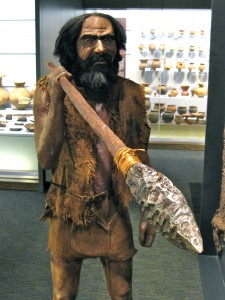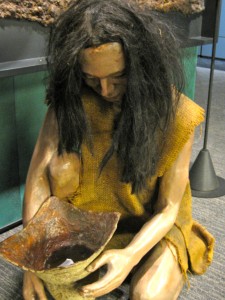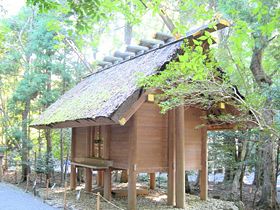
Jomon man
Here’s an interesting quote:
“Japanese matsuri (festivals) resemble so much Balinese ones that one could wonder if one was not copied from the other. During cremations in Bali, the dead body is carried on a portable shrine, very much in the way that the Japanese carry their mikoshi. Balinese funerals are joyful and people swinging the portable shrine in the streets are making loud noise to scare the evil spirits.
Basically, Balinese religion is a form of Hinduism that has incorporated the aborigenal animist religion. Japanese Shintoism is also a variety of animism, and is practised side-by-side with Buddhism, a religion derived from Hinduism (Buddha himslef was born a Hindu). There are lots of other cultural similarities between ancient cultures of Indonesia and Japan.
For example, both Balinese temples and Japanese shrines, as well as traditional Japanese and Balinese houses have a wall surrounding them, originally meant tp prevent evil spirits from penetrating the property. Despite the radical changes that Indonesian culture underwent after the introduction of Islam and Christianity, and the changes that Buddhism brought to Japan, it is still possible to observe clear similarities between the supposed original prehistoric cultures of the two archipelagoes.”
Things get even weirder when one considers the linguistic connection:
“From a linguistic point of view, Bahasa Indonesia/Malaysia and Japanese language share only a few similarities, but nonetheless striking ones. Apart from the very similar pronunciation in both languages, there is the same hierarchical differences in personal pronouns. For example “you” is either anda or kamu with the same meaning and usage as anata and kimi in Japanese. Likewise, the Japanese verb suki (“to like”) translates suka in Bahasa. Such similarities are probably more than mere coincidences, and may reveal a common origin.”

Jomon woman
So how is one to explain this? Well, research in genetics has turned up compelling evidence of migratory links.
“The Paleolithic Jomon people appear to have come from Austronesia during the Ice Age, before Japan was resettled by Bronze-age rice farmers from the continent. The Chinese had previously expanded southward to South-East Asia. The original inhabitants of Indonesia and the Philippines might have been related to Dravidians of Southern India. Y-haplogroup C, which has been associated with the first migration of modern humans out of Africa towards Asia, is relatively frequent in Kerala (southern tip of India) and Borneo. These early Austronesians are thought to have been the ancestors of the Ice Age settlers of Japan.”
So there we have it: Jomon Japanese have a southern Austronesian origin. The Jomon era was roughly from 15,000 BC to 300 BC, so what’s that got to do with modern Japan? Well, Jomons never died out but were assimilated into the immigrant waves from Korea and China that created the Yayoi culture. Research has shown that 43% of modern Japanese men carry a Y-chromosome of Jomon origin.
The Polynesian roots of the Japanese live on. And they’re evident in the form of modern Shinto too.

The style of shrine at Ise is said to have Polynesian influences
*********************************************************************************
Information draws on the following article:
http://www.wa-pedia.com/history/origins_japanese_people.shtml

no…..does the author even know what the 43percent jomon gene.s are?? its called haplogroup D M174. its not at all found in the pacific and rare in the way south. in japan subclade D2 exists which cant be found in the south anywhere. D, D1, and D3 make up at times over 50 percent of the tibetan male population. tibet is south central asia a part of the great western chinese expanse east of khazakhstan and south of the altai mountains.
Y chromosome haplogroup D is found in the Asian Pacific rim but in very minute frequencies the highest outside of Japan is in Sumatra and less in Borneo. The Philippines has a frequency in the single digits. Regardless, I too disagree with the conclusion that the Jomon were Austronesian speakers. We don’t know what languages the Jomon spoke and it is far more plausible that the Jomon spoke languages related to those of Ainu. Even the material culture of the Jomon is significantly different from that of the Austronesians. Whoever the Jomon people were, they represent a vestige of east Asians that should not be identified with any modern culture today.
The original inhabitants of the Philippines & Indonesia were Australoids (a broad classification for Melanesians, Dravidians, Negritos & Australian Aborigines). The Austronesians came much later, about 5-6,000 years ago and swept over SE Asia & the Pacific Islands. So the original inhabitants of SE Asia (Philippines & Indonesia) were not Austronesians. As for the Chinese expanding towards SE Asia, that came much later. I think you are confusing the Austronesian migration into SE Asia for the “Chinese” because their homeland was originally from China. Austronesians from “China” was not China YET when they left it. They left due to many factors; 1t probably has to do with the expanding Hans. The ones who stayed behind assimilated into Han culture. But just because Austronesians came from China does not equate to them being Chinese. The Chinese is equated to the Hans & the culture they have.
Also, why would “rice” be associated with non-Austronesians? Even in China, the origin & tradition of rice agriculture is associated with Austronesians, the Hans weren’t originally rice agriculturalists. Rice farming is associated with Austronesians, even Koreans have marginal rice tradition & culture, & they are associated with the Yayoi. If you look at Austronesian languages, they have words for different forms of rice like no other. Rice culture I believe originated from Austronesians, not non-Austronesians.
Everything that nenabunena wrote is correct. Modern Austronesian speakers are the result of expansions from southern China that occurred during the neolithic. Ancient China, let alone prehistoric China should NOT be identified with modern Han China. Many people forget that the modern nation of China was an EMPIRE created through imperial conquest of non-Chinese nations which is clearly written and described in the Han historical records. The vast majority of modern Chinese may not even have actual Han Chinese ancestry, but if you bring this fact up the Chinese nationals will bite your head off! But I digress. The main point I want make is that whatever affinities modern Japanese has with Austronesians is NOT due to Jomon but on the contrary due to Yayoi or Japonic origins itself! This is because NON of the Ainu words show affinities to Austronesian while only Japonic words including Ryuyku do. The situation is a little more complicated since according to the Swadesh list of cognates, approximately 45 out a 100 words in Japanese show Austronesian cognates but then again the SAME ratio (45/100) of words in Japanese also show cognates with Koreonic languages and about a quarter (23) overlap and are shared by both Koreonic and Austronesian, not to mention cognates found in Altaic and Daic (Tai-Kadai)! All of this shows that proto-Japonic developed in an area intermediate between Austronesian and Koreonic and more distant to Altaic and Daic. As I said, the Jomon people who were likely Ainu ancestors are something else entirely.
How certain are we that Ainu are related to Jomon? Couldn’t Ainu also be mostly unrelated prehistoric migrants from Siberia? After all, isn’t the genetic markup distinct to Ainu mostly only found in the north, while Jomon ancestry would mean that it should be found all over Japan?
Many thanks for that thought. I can’t claim any expertise in genetic matters and used to think along similar lines to yourself too. However, recently I’ve read accounts by people who seem to know better than myself that Ainu were part of the Jomon people or shared genetic characteristics with them. This kind of thing for instance: ‘According to Matsumura (1999:36-40), reflecting current physical anthropology, the Ainu and Jomon tooth pattern falls into the category known as the Sundadont.’ The writer then links them with Australian aboriginals. (https://search.yahoo.com/yhs/search?p=ainu+origins+jomon&ei=UTF-8&hspart=mozilla&hsimp=yhs-001). Or this for instance: “Looking at the skeletal and cranial remains of the ancestors of the Ainu on Hokkaido, they most closely resemble the Jomon people. The Ainu of today are partially descended from Jomon, and from the Jomon-Yayoi mixture of the Emishi people.” (https://suite.io/paula-i-nielson/2vy92dq)